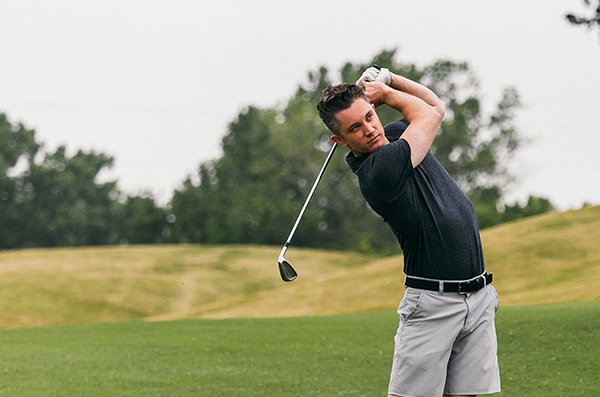-
{{link.label}}{{link.label}}
When Should You Change Your Golf Clubs?
On this page
“Is it time to change my clubs?” - A question that’s undoubtedly popped into your mind several times over the golf season. This question may be daunting to many golfers, which is why we’re here to help you out.

There are some key points that you should keep in mind when you’re deciding whether it is time to change your clubs or not. While some of these points are directly related to the equipment itself, some of them are entirely dependent on the player.
Here’s what we’ll be covering in this one:
- Worn-Out Grooves
- Loss in Distance
- Old Tech
- Aging Body
- Condition of the Grips
Worn-Out Grooves

Your main goal when hitting wedges, and even irons, is to create the right amount of spin with your ball to hit the desired shots. The best way to manage this spin is to have sharp grooves that will bite hard on the ball.
Dull grooves are a good indication that it is time to move on from your old golf clubs. The most efficient way to see if you’ve lost too much spin on your club is to test it in front of a swing monitor that can display your ball spin.
However, we realize that not everyone has access to one of those, so here is a quick tip for you. While you may not be able to spin the ball back like the pros, you’re certainly able to spin it enough to stop the ball.
If you’re trying to hit spinning wedge shots that are not stopping and simply rolling forward when they settle on the ground, this is another good indication that your grooves are toast.
You can also submit your club faces to the eye test, but it might not offer the most accurate representation of their condition at impact.
Loss in distance

There’s been more and more talk about drivers losing their “pop” after some time. Though this may apply to some specific clubs, it certainly doesn’t apply to all of them as we’ve learned from our extensive experience in selling pre-loved golf clubs.
If you do fall victim to one of these unfortunate clubs after years of loyal service, it will be time to make a change. The decline in performance will be quite obvious and will show on the course as you’ll lose distance off the tee.
There is no perfect way to test this other than measuring your driving distances, either out on the course or with a launch monitor. Unless other factors like wind, temperature, or injuries are badly affecting you at the moment, a loss in distance is a good indicator that your driver has served its time.
The same applies to your irons as the club faces will also decrease in performance over time. This is especially true with cavity-back irons which tend to end up with a caved-in face after years of making contact with a golf ball.
Old tech
As some drivers will lose out on pop and distance over time, some clubs will simply be too old to offer you any valuable performances. You know what clubs we’re talking about. The ones that have been sitting in the corner of a room or the garage, waiting for some sunshine.
These clubs are likely to be over a decade old, maybe even dating back to the ‘90s. They’ll probably get you through your annual 18-hole round with your friends, but if you’re looking to pick up the sport more seriously (there’s never been a better time), you’ll definitely need an update.
Though these clubs could probably still serve an advanced golfer who really likes old-school blades, you’ll be better off with something more recent. No need to go for the clubs of the year, but clubs from the past five years will usually provide you with an immense upgrade from those old dust collectors.
Aging body

Sometimes, your clubs are in tip-top shape, but your physical strength has changed. It’s totally normal, and unless you’re Bernhard Langer, it happens to everyone at one point or another! If you begin to notice you’re losing swing speed off the tee, it may be time to consider adapting your golf clubs.
Using the right equipment to fit the needs of your body is essential. This also means that you have to be honest with yourself and realize that you sometimes need to move on from steel shafts and transition to whippier graphite shafts.
While age will change your body, there are other physical reasons that would motivate you to change your needs from your golf clubs. Surgeries and injuries can certainly limit your physical abilities, which may force you to switch some parts of your set as well.
Condition of the grip

This final point will allow you to make another important decision. Yes, you can certainly go ahead with a new set of grips if your clubs are still in great shape. However, if they check any of these other boxes mentioned above, it might be time for a change.
It’s actually the perfect time for a change as you could send in your old clubs in Golf Avenue’s trade-in process. This will allow you to either make some sweet cash with clubs that have served their time or bank in some customer credit to use on your next set of clubs.
We understand how difficult it can be to get rid of some clubs that you’ve had in your bag for years. But it’s important to consider the points mentioned above at the end of the season before putting your clubs away for the winter.
Finally, if you’re still letting some old clubs simply collect dust, don’t force them to suffer any longer, but most importantly, don’t leave your wallet empty and send those clubs in for a trade-in. You’ll only benefit from this as you’ll end up with better clubs and more money in your pockets!
Until next time,
The Golf Avenue Team
Further reading
Used golf clubs are usually a budget-friendly alternative for golfers over brand-new golf clubs. Discover all their perks!
In this one, we discuss the signs that might indicate that you need to change your drivers and how a damaged driver can affect your game. Check it out!



